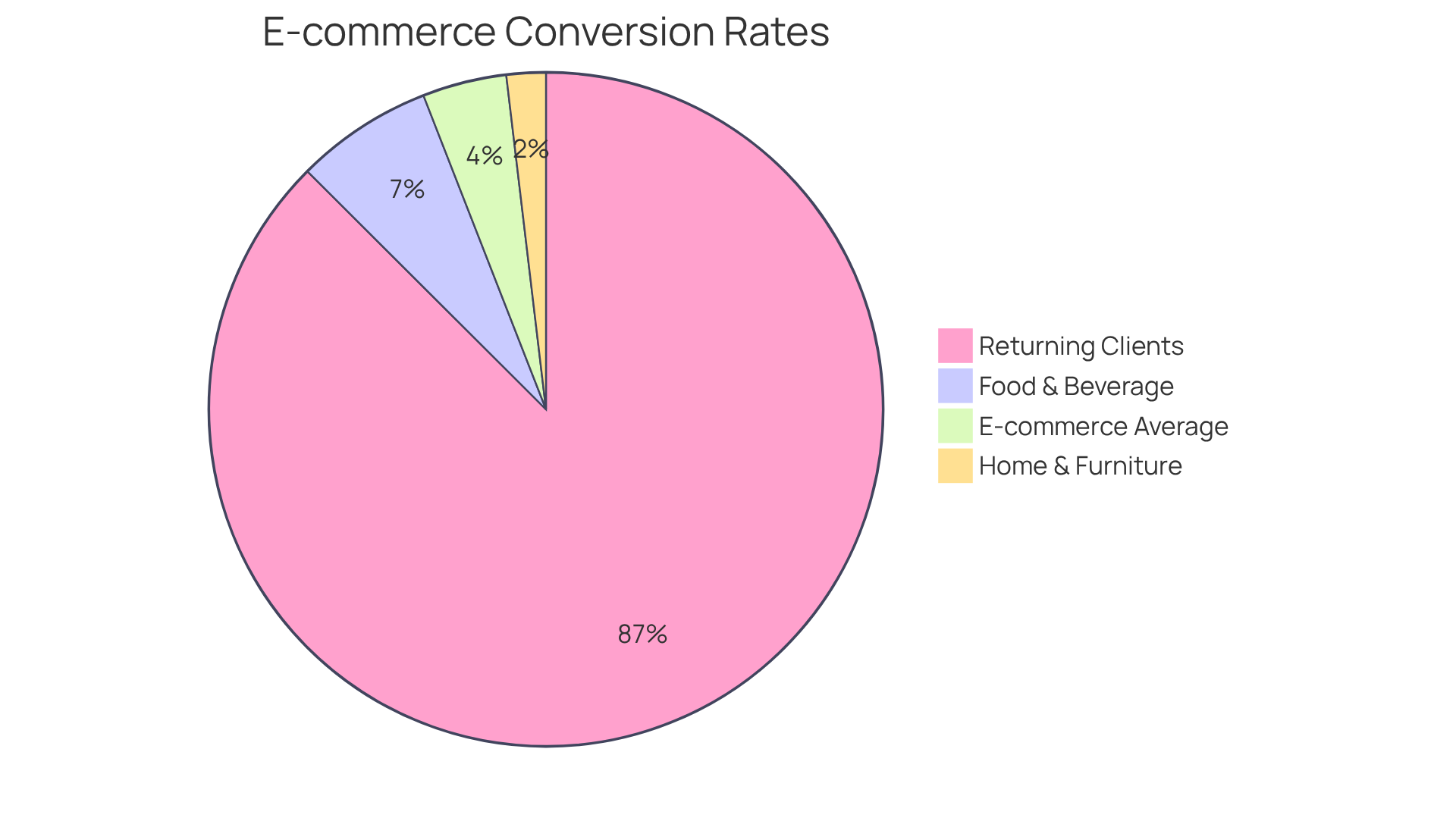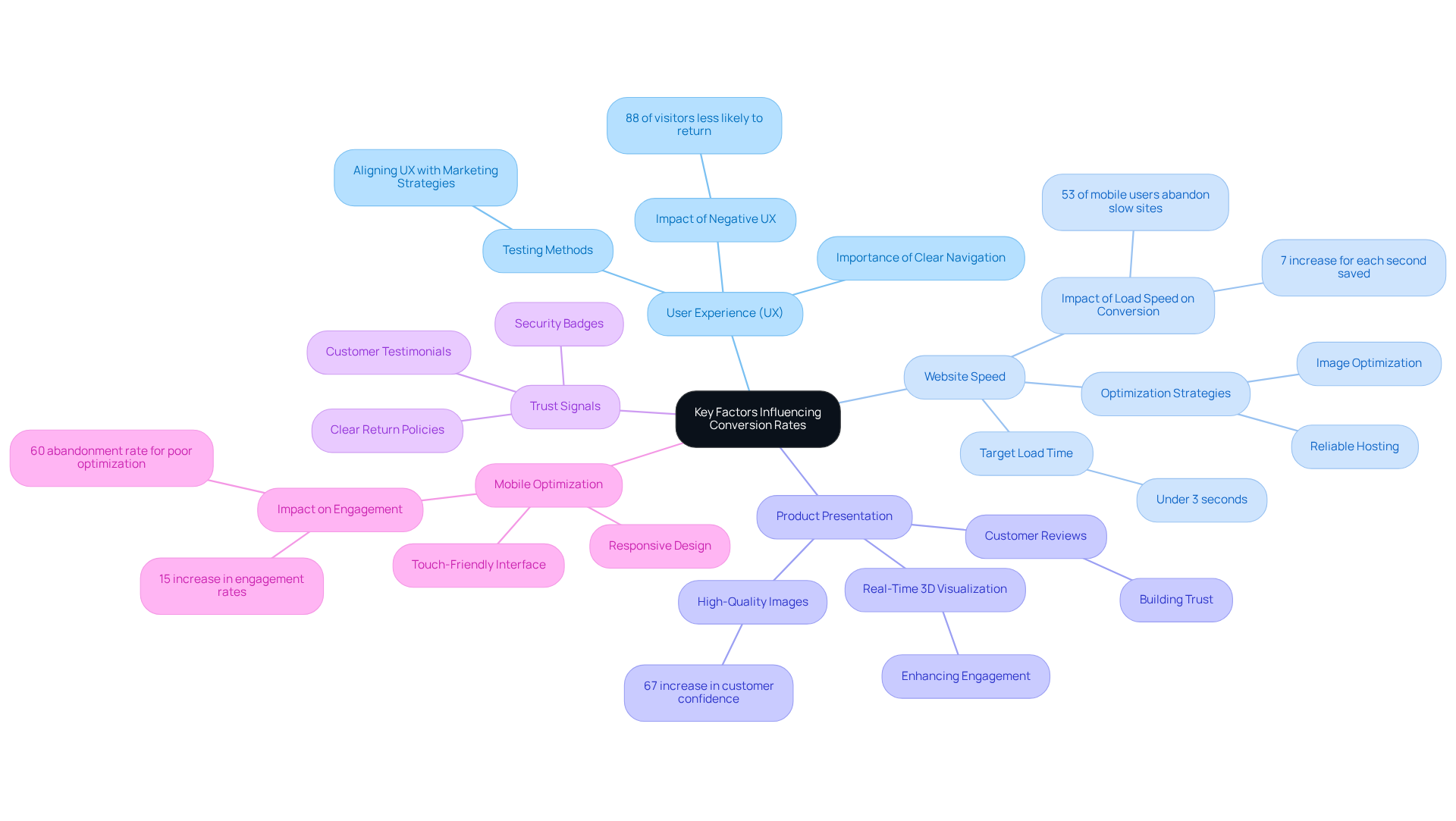
Overview
To significantly enhance e-commerce conversion rates for direct-to-consumer (DTC) brands, it is essential to implement key strategies that focus on optimizing user experience, enhancing product presentation, and leveraging social proof. These strategies are not just theoretical; they are backed by data analytics and continuous A/B testing, which have proven to boost customer engagement and sales effectively.
By prioritizing user experience, brands can create a seamless shopping journey that encourages purchases. Enhancing product presentation through high-quality images and compelling descriptions captures attention and fosters interest. Furthermore, leveraging social proof—such as customer reviews and testimonials—builds trust and generates desire among potential buyers.
The impact of these strategies is clear: they lead to higher conversion rates. Brands that adopt these practices not only see an increase in sales but also cultivate a loyal customer base. Therefore, it is crucial for DTC brands to embrace these approaches and continuously refine them based on analytics and testing.
In conclusion, the path to improved conversion rates lies in a strategic focus on user experience, product presentation, and social proof. By taking action on these insights, brands can position themselves for success in the competitive e-commerce landscape.
Introduction
E-commerce conversion rates are a vital indicator of online retail success, showcasing how effectively a website transforms visitors into paying customers. As the average conversion rate is projected to remain between 2% and 4% in the coming years, direct-to-consumer (DTC) brands face a significant challenge: enhancing these figures to secure sustainable growth.
To not only meet but exceed industry benchmarks, DTC brands must adopt strategic approaches that convert casual browsers into loyal buyers. What specific strategies can these brands implement to achieve this transformation? By focusing on targeted marketing efforts, optimizing user experience, and leveraging data analytics, brands can significantly improve their conversion rates.
In this article, we will explore actionable insights and proven tactics that can help DTC brands elevate their performance in the competitive e-commerce landscape.
Understand E-Commerce Conversion Rates
E-commerce success metrics are vital indicators of your online shop's performance, specifically reflecting the proportion of visitors who complete a desired action, typically making a purchase. To determine your conversion rate, apply this straightforward formula:
Conversion Rate = (Number of Sales / Total Visitors) × 100
For example, if your store attracted 1,000 visitors and 50 of them made a purchase, your conversion rate would stand at 5%. This metric is crucial as it directly impacts your revenue and profitability.
Looking ahead to 2025, the average e-commerce conversion rate is projected to range between 2% and 4%, varying by sector. Notably, the Food & Beverage industry boasts the highest success ratio at 4.9%, while the Home & Furniture sector lags behind at just 1.4%. Understanding where you stand in relation to these benchmarks is essential to improve conversion rate ecommerce, as it allows you to identify areas for improvement and establish realistic optimization goals.
Moreover, consider that returning clients convert at impressive rates of 60-70%. By enhancing customer loyalty and engagement, you can significantly improve conversion rate ecommerce and boost your overall performance in attracting and retaining customers. This strategic focus not only elevates your conversion rates but also works to improve conversion rate ecommerce, fortifying your business's long-term success.

Identify Key Factors Influencing Conversion Rates
Several key factors can significantly influence your e-commerce conversion rates:
-
User Experience (UX): An effortless and instinctive experience is essential for enhancing outcomes. Websites must feature clear navigation, strategically placed calls-to-action (CTAs), and minimal distractions. Studies show that 88% of visitors are less inclined to return to a site after a negative experience, underscoring the importance of investing in accessible design. Parah Group employs rigorous testing methods to ensure that UX aligns with marketing strategies, thereby improving engagement and success metrics.
-
Website Speed: Page load speed is crucial for visitor retention and sales rates. Aim for a loading time of under three seconds; research indicates that a 7% increase in success occurs for each second reduced in load time. Slow-loading pages frustrate users, leading to abandonment—53% of mobile users will leave a site that takes longer than three seconds to load. Parah Group's data-driven approaches identify and implement enhancements that improve loading times, ultimately boosting results.
-
Product Presentation: High-quality images and detailed product descriptions significantly enhance product appeal. Statistics reveal that high-quality images can increase customer confidence by 67%. Additionally, incorporating customer reviews builds trust and encourages purchases, as consumers often rely on peer feedback when making decisions. Parah Group leverages data analytics to refine product presentation, ensuring it resonates with target audiences and drives sales.
-
Trust Signals: Incorporating trust signals such as security badges, customer testimonials, and clear return policies alleviates concerns and fosters confidence in potential buyers. A professional website design reinforces trustworthiness, making customers more likely to complete their purchases. Parah Group's expertise in harmonizing marketing approaches with trust-building elements enhances customer confidence and drives results.
-
Mobile Optimization: With over half of global web traffic coming from mobile devices, ensuring your site is fully responsive is essential. A well-optimized mobile experience can enhance engagement rates by 15%, while poor mobile optimization can lead to a staggering 60% abandonment rate. Parah Group's comprehensive strategies ensure that mobile optimization is a key focus, maximizing profitability through effective user engagement.
By concentrating on these elements and employing a data-informed, comprehensive strategy, brands can create a more engaging shopping experience that promotes transactions and improves overall profitability. Additionally, investing in conversion rate optimization (CRO) efforts yields long-term ROI, making it a crucial strategy for direct-to-consumer (DTC) brands.

Implement Effective Strategies to Boost Conversion Rates
To effectively enhance your e-commerce conversion rates, consider implementing the following strategies:
-
Optimize Your Checkout Process: Streamline the checkout experience by minimizing the number of steps required to complete a purchase. Implement guest checkout options and reduce form fields, as lengthy forms can deter up to 27% of users from completing their transactions. Parah Group has assisted brands such as STRNG Seeds in enhancing their average order values (AOVs) by introducing streamlined checkout processes and providing complimentary gifts for orders above a specific cart size, leading to notable boosts in sales.
-
Use A/B Testing: Regularly conduct A/B tests on various website elements, such as calls to action (CTAs), product pages, and layouts. This approach has demonstrated success, with companies that conduct more tests observing substantial enhancements in success metrics. For instance, A/B testing adjustments to ad headlines resulted in a 12% revenue increase for Bing. Companies that collaborated with Parah Group, such as Grab Green, saw a 73% boost in success through strategic testing and optimization.
-
Leverage Social Proof: Prominently display customer reviews, ratings, and testimonials on product pages. Research indicates that nearly 50% of consumers trust online reviews as much as personal recommendations, which can significantly influence purchasing decisions. Parah Group's case studies demonstrate that improving social proof on product pages has resulted in quantifiable rises in sales for their clients.
-
Create Compelling CTAs: Utilize clear, action-oriented language in your CTAs. Experiment with various colors and positions, as placing CTAs above the fold can enhance results by up to 317%. Phrases like 'Add to Cart' are more effective than generic options like 'Click Here'. Parah Group's optimization approaches helped improve the conversion rate ecommerce by 35% for their apparel brand client.
-
Implement Scarcity and Urgency: Employ tactics such as limited-time offers or low-stock notifications to instill a sense of urgency. This strategy can prompt quicker purchasing decisions, as consumers are often motivated by fear of missing out (FOMO). Parah Group's work with various brands has shown improved sales through these techniques.
-
Personalize the Shopping Experience: Use data analytics to tailor product recommendations and marketing messages based on user behavior and preferences. Customized experiences can greatly improve engagement and response rates, as customers are more inclined to react favorably to pertinent offers. Parah Group has effectively executed tailored approaches that have resulted in a 90% rise in AOV for their clients.
By implementing these strategies, brands can foster a more engaging shopping experience that can help improve conversion rate ecommerce and effectively boost sales.

Utilize A/B Testing and Analytics for Ongoing Optimization
To maximize the effectiveness of your strategies to improve conversion rate ecommerce, continuous A/B testing and analytics are crucial.
-
Set Clear Goals: Establish specific objectives for your A/B tests—whether it’s to improve conversion rate ecommerce, minimize cart abandonment, or increase click-through rates. This clarity will guide your testing strategy and ensure focused efforts.
-
Choose the Right Tools: Implement analytics tools like Google Analytics, Optimizely, or Hotjar to monitor visitor behavior and gather data on interactions with your site. These tools are essential for understanding how changes impact user engagement. Notably, only 5.83% of the top 1 million sites are using CRO tools, highlighting the competitive advantage of adopting these technologies.
-
Conduct A/B Tests: Regularly experiment with various elements of your website, including headlines, images, and call-to-action buttons. For instance, A/B testing approaches resulted in a 24% increase in sales and over $14 million in additional revenue for a jewelry eCommerce brand, effectively illustrating how to improve conversion rate ecommerce through organized testing.
-
Monitor Key Metrics: Track critical metrics such as conversion rates, bounce rates, and average order values to assess the effectiveness of your modifications. This ongoing monitoring is vital for understanding the impact of your changes and making informed decisions.
-
Iterate Based on Data: Leverage insights from your tests and analytics to inform future optimizations. Continuous refinement of your strategies is essential to align with evolving consumer behaviors and preferences, ensuring sustained growth. For example, a leading house plans retailer achieved a 25% increase in revenue per user through mobile UX optimization, illustrating the benefits of data-driven decisions.
By committing to a cycle of ongoing testing and analysis, brands can maintain a competitive edge and consistently improve conversion rate ecommerce.

Conclusion
Improving e-commerce conversion rates is not just beneficial; it’s essential for direct-to-consumer (DTC) brands aiming to maximize online sales and profitability. Understanding conversion rates and identifying key influencing factors are crucial steps in this journey. By implementing effective tactics that enhance the shopping experience, brands can create an environment that not only encourages purchases but also fosters customer loyalty.
Key insights reveal the necessity of:
- Optimizing the checkout process
- Leveraging A/B testing
- Utilizing social proof to build trust with potential buyers
Each of these strategies plays a vital role in reducing cart abandonment and boosting sales figures. Moreover, ongoing optimization through analytics and data-driven decision-making can significantly enhance long-term performance, ensuring that brands remain competitive in the ever-evolving e-commerce landscape.
Ultimately, a commitment to improving e-commerce conversion rates leads to immediate financial benefits and establishes a foundation for sustained growth and customer engagement. By embracing these strategies, DTC brands can effectively navigate the complexities of online retail, transforming visitors into loyal customers and driving profitability in the digital marketplace.
Frequently Asked Questions
What is an e-commerce conversion rate?
The e-commerce conversion rate is a metric that indicates the proportion of visitors to an online shop who complete a desired action, typically making a purchase.
How do you calculate the conversion rate?
The conversion rate is calculated using the formula: Conversion Rate = (Number of Sales / Total Visitors) × 100. For example, if a store has 1,000 visitors and 50 make a purchase, the conversion rate is 5%.
What is the projected average e-commerce conversion rate for 2025?
The average e-commerce conversion rate for 2025 is projected to range between 2% and 4%, depending on the sector.
Which industry has the highest e-commerce conversion rate?
The Food & Beverage industry has the highest e-commerce conversion rate, boasting a rate of 4.9%.
Which industry has the lowest e-commerce conversion rate?
The Home & Furniture sector has the lowest e-commerce conversion rate at just 1.4%.
Why is it important to understand conversion rate benchmarks?
Understanding conversion rate benchmarks is essential for identifying areas for improvement and establishing realistic optimization goals to enhance overall performance.
How do returning clients impact conversion rates?
Returning clients have impressive conversion rates of 60-70%, indicating that enhancing customer loyalty and engagement can significantly improve overall conversion rates.
What strategies can improve e-commerce conversion rates?
Improving customer loyalty and engagement through strategic focus can enhance conversion rates and boost overall business performance.
FAQs











